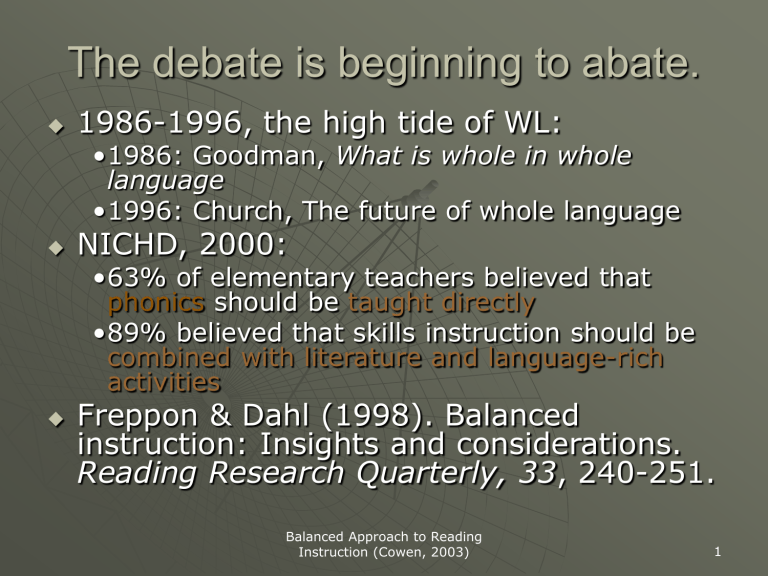The debate is beginning to abate. NICHD, 2000:

The debate is beginning to abate.
1986-1996, the high tide of WL:
•1986: Goodman, What is whole in whole language
•1996: Church, The future of whole language
NICHD, 2000:
•63% of elementary teachers believed that phonics should be taught directly
•89% believed that skills instruction should be combined with literature and language-rich activities
Freppon & Dahl (1998). Balanced instruction: Insights and considerations.
Reading Research Quarterly, 33, 240-251.
Balanced Approach to Reading
Instruction (Cowen, 2003) 1
Characteristics of BI
comprehensive, integrated, multicomponential, demanding
T must know a great deal about emergent literacy, assessment-based instruction, phonological and phonemic awareness, the alphabetic principle, phonics and word study, selecting appropriate leveled readers, reader response, writing process, and constructivist learning (p.2).
Balanced Approach to Reading
Instruction (Cowen, 2003) 2
Is BI WL in disguise?
Moats (2000), a harsh critic of WL
•BI is used only to advance WL!
•“. . . whole language about how reading is learned has been contradicted by scientific investigations” (a wrong assertion)
•“. . . reading science is clear: young children need instruction in systematic, synthetic phonics in which they re taught sound-symbol correspondences singly, directly, and explicitly.” (cited in Cowen, p.3)
Balanced Approach to Reading
Instruction (Cowen, 2003) 3
Def. of BI
(Spiegel, 1998)
The balanced approach to reading instruction
• is built on research,
• views teachers as informed decision makers and therefore is flexible, and
•is built on a comprehensive view of literacy
Balanced Approach to Reading
Instruction (Cowen, 2003) 4
Def. of BI
(Spiegel, 1998)
Six major components of BI:
•Literacy involves both reading and writing
•Reading is not just word identification, but word recognition is part of reading.
•Readers must be able to take different stances in reading: aesthetic and efferent
•Writers must be able to express meaningful ideas clearly.
•Writing is not just grammar, spelling, and punctuation, but those are all part of effective writing.
•A comprehensive program develops life-long readers and writers.
Balanced Approach to Reading
Instruction (Cowen, 2003) 5
Def. of BI
(Holdaway, 1979) 1/2
Five elements of BI:
•Using guided literacy: Using the basic series (individualized leveled texts), monitoring progress (i.e., Clay’s running records), and decoding and reading for meaning.
•Using Language Experience Procedures:
Linking language and experience to spoken and written language.
Balanced Approach to Reading
Instruction (Cowen, 2003) 6
Def. of BI
(McIntyre and Pressley)
Key practices of BI (Vygotsky and Clay):
•Using an assessment-to-instruction model of teaching;
•respecting children’s background, language, interests, and abilities;
•Using information about the learner’s culture, values, knowledge, and interests to plan instruction;
•teaching strategies and skills explicitly using a whole-part-whole approach that returns the learner to meaningful whole texts; and
•providing planned, systematic instruction on needed strategies
Balanced Approach to Reading
Instruction (Cowen, 2003) 7
Def. of BI
(Cohen, 2003) 1/5
A balanced reading program should provide
•authentic, real literature, including nursery rhymes, fairy tales, and poems that provide students with opportunities to read and enjoy a variety of genres (fiction, nonfiction, and themes);
•a very comprehensive writing-process program that engages students in daily writing, peer editing, and publishing activities;
•an integrated language arts and phonics skillsdevelopment approach that requires skills to be taught from the context of real literature as well as from student writing;
Balanced Approach to Reading
Instruction (Cowen, 2003) 8
Def. of BI
(Cohen, 2003) 2/5
A balanced reading program should provide
•attention to the three cueing systems— semantic, syntactic, and graphophonics—to give students the required blend of skills, enabling them to read texts meaningfully and with understanding;
•metacognitive, self-monitoring, fix-up, and scaffolding strategies to support student word recognition and reading comprehension;
•Opportunities to develop learning strategies to use in new situations and to acquire new information to develop higher order thinking skills.
Balanced Approach to Reading
Instruction (Cowen, 2003) 9
Def. of BI
(Cohen, 2003) 3/5
A balanced reading program should provide
•Ongoing assessment for continuous progress that engages students at the independent or instructional reading level and avoids reading materials at their frustration reading level;
•oral storytelling, dictation, and other listening activities, including phonological and phonemic awareness development at the primary level;
•an interdisciplinary content area reading approach, stressing the use of a wide variety of trade books as well as textbooks;
Balanced Approach to Reading
Instruction (Cowen, 2003) 10
Def. of BI
(Cohen, 2003) 4/5
A balanced reading program should provide
•shared reading, guided reading, independent reading, and one-on-one instruction, particularly for struggling readers;
•time commitment to on-task reading, writing, and related language arts activities;
•reading/learning centers for exploration and discovery in all areas of the language arts and for managing individual and differentiated instruction.
Balanced Approach to Reading
Instruction (Cowen, 2003) 11
Def. of BI
(Cohen, 2003) 5/5
A balanced reading program should provide
•opportunities for developing and maintaining a language rich environment;
•a supportive, nurturing classroom that meets the diverse needs of students and that also promotes listening, speaking, reading, writing, and viewing as joyful experiences; and
•promotion of ongoing family involvement in children’s literacy development.
Balanced Approach to Reading
Instruction (Cowen, 2003) 12
Def. of BI
(Cohen, 2003)
“A balanced reading approach is researchbased, assessment-based, comprehensive, integrated, and dynamic, in that it empowers teachers and specialists to respond to the individual assessed literacy needs of children as they relate to their appropriate instructional and developmental levels of decoding, vocabulary, reading comprehension, motivation, and sociocultural acquisition, with the purpose of learning to read for meaning, understanding, and joy” (p.10).
Balanced Approach to Reading
Instruction (Cowen, 2003) 13



